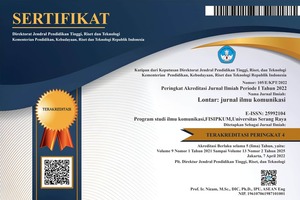Digital Content Marketing as Business Strategy for Japanese Video Game Company in the Network Society
DOI:
https://doi.org/10.30656/lontar.v12.i2.9496Keywords:
CapCom, Video Game, Digital Content Marketing, Value Added ServiceAbstract
This study examines how CapCom, a company in the Japanese video game industry, increased its sales through digital content marketing. Japan is one of the countries that has strength in the global economy in various aspects of the economy, one of which is the video game industry. The video game industry in Japan has gone through several periods ranging from the arcade era to the handheld era. CapCom is one of the Japanese companies engaged in the video game industry. The company focuses its business on digital content marketing. This is also CapCom's effort to increase its sales. This research uses Castells' theory of network society and Koiso and Kanttila's concept of digital content marketing with a leatherative research method and document analysis obtained from online sources. Based on the analysis of data collected from various sources, CapCom's effort to increase its sales through digital content marketing is by utilizing global networks for various marketing purposes. Then, CapCom also tends to emphasize value-added services by offering DLC (downloadable content) on its digital content to increase sales and consumer loyalty to the company.
References
Allen, M., & Sakamoto, R. (2006). Popular Culture, Globalization and Japan. Routledge.
Bradley, S., Kim, C., Kim, J., & Lee, I. (2012). Toward an evolution strategy for the digital goods business. Management Decision, 50(2), 234–252. https://doi.org/10.1108/00251741211203542
Castells, M. (2000). Toward a Sociology of the Network Society. In Sociology (Vol. 29, Issue 5). https://www.jstor.org/stable/2655234
Castells, M. (2008). Manuel Castells Materials for an Exploratory Theory of the Network Society. https://doi.org/https://doi.org/10.1111/j.1468-4446.2000.00005.x
Castells, M., & Cardoso, G. (2005). The Network Society : From Knowledge to Policy. John Hopkins Center for Transatlantic Relations. http://transatlantic.sais-jhu.edu
Chen, C. Y. (2013). Is the video game a cultural vehicle? Games and Culture, 8(6), 408–427. https://doi.org/10.1177/1555412013493349
Cresswell, J. W. (2009). Research Design : Qualitative, Quantitative, and Mixed Methods Approaches (Third). SAGE Publications Inc.
Kent, S. L. (2001). The Ultimate History of Video Games. Three Rivers Press.
Kerr, A. (2006). THE BUSINESS AND CULTURE OF DIGITAL GAMES. SAGE Publications Ltd.
Kerr, A. (2017). GLOBAL GAMES : Production, Circulation, and Policy in the Networked Era. Routledge.
Khaled, P. D., & Iskandar, K. (2022). In-App Purchase in Japanese Free-To-Play Mobile Game: The Motivation of Indonesian Players. Budapest International Research and Critics Institute (BIRCI-Journal), 5. https://doi.org/10.33258/birci.v5i1.4362
Koiso-Kanttila, N. (2004). Digital Content Marketing: A Literature Synthesis. Journal of Marketing Management, 20(1–2), 45–65. https://doi.org/10.1362/026725704773041122
Koyama, Y. (2023). Translational Systems Sciences 35 History of the Japanese Video Game Industry (Vol. 35). Shibaura Institute of Technology. https://doi.org/https://doi.org/10.1007/978-981-99-1342-8
Rowley, J. (2008). Understanding digital content marketing. Journal of Marketing Management, 24(5–6), 517–540. https://doi.org/10.1362/026725708X325977
Van Dijk, J. (2006). The Network Society (2nd ed.). Sage.
Downloads
Published
Issue
Section
License

This work is licensed under a Creative Commons Attribution-ShareAlike 4.0 International License.
By submitting an article to the journal, the author(s) agree to transfer the published article's copyright to the journal, which will act as the publisher. This means the journal will have the right to publish the article in various forms, including reprints. The journal will maintain the publishing rights to the published articles.
In line with the license, authors and third parties (readers, researchers, and others) are allowed to share and adapt the material. In addition, the material must be given appropriate credit, provided with a link to the license, and indicated if changes were made. If authors remix, transform, or build upon the material, authors must distribute their contributions under the same license as the original.





